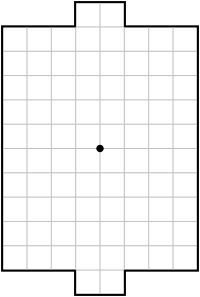Paper Soccer

An example board
|
|
| Genre(s) |
Paper and pencil game Abstract strategy game |
|---|---|
| Players | 2 |
| Setup time | seconds |
| Playing time | five minutes |
| Synonym(s) | Paper hockey |
Paper soccer (or paper hockey) is an abstract strategy game played on a square grid representing a soccer or hockey field. Two players take turns to extend a line representing the position of a ball, until it reaches one of the grid's two goal spaces. A traditional paper-and-pencil game, it is commonly played in schools and can be found in children's magazines. Many computer implementations of the game also exist. Despite the game's simple rules, paper soccer has several expanded strategies and tactics.
The game's pitch is drawn as a rectangle on a grid, with small extended rectangles in the center of each of the two shortest sides to represent the two goals. The grid can be of any size, although both sides should be an even number of squares to allow a center point for kickoff. The goal areas are typically 2 × 1 squares in size.
A "ball" is marked as a dot in the center of the pitch. Players alternately move the ball to a new point by drawing a line from its current position to a new one. Each move must be to a point orthogonally or diagonally adjacent. The ball cannot be moved beyond the boundary of the pitch, nor along a line that has already been drawn.
If the ball is moved to a point which already has one or more lines connected to it (including the perimeter of the pitch), the ball "bounces" and the player immediately takes another turn. The player's move ends only when the ball reaches a point with no existing lines.
The winner is the player who places the ball in their opponent's goal. A player also wins if their opponent scores an own goal. If the ball reaches a point from which it cannot be moved (such as a corner of the pitch) this is regarded as a draw, or a loss for the player unable to move, depending on the rules being played by. In some versions of the game, both of these moves can be illegal.
The players can regulate the pitch's shape in various ways by altering the pitch's dimensions or the placement of the gates. In some variants, one or more special lines may be added to the pitch. This modification is found in computer applications, and expanded variants of this modification are used by PDE Football.
In some variants, gameplay can be continued from the central pitch's point after a goal is scored or after a play is blocked. The player who did not score moves first from the central point. The game is finished when a move from the central point is not possible, and the player who scored the most goals wins.
...
Wikipedia
